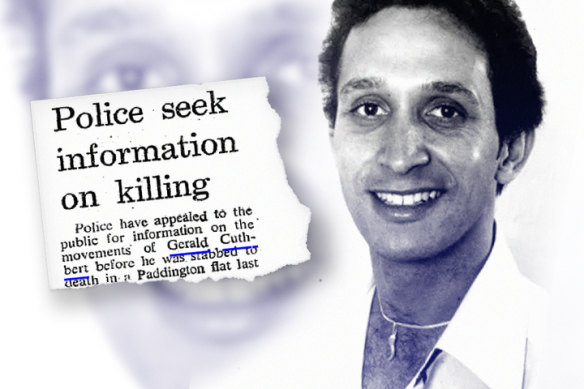This was published 1 year ago
‘Frenzied attack’: Crucial evidence lost from scene of Paddington murder
The killer responsible for a frenzied murder in a Paddington apartment in inner-city Sydney may have walked free because crucial evidence was lost, an inquiry has heard.
The naked body of Gerald Cuthbert, 27, was found in a pool of blood on a bed in a friend’s apartment on October 18, 1981. There were more than 60 stab wounds on his body and his throat had been cut.

Gerald Cuthbert and a Sydney Morning Herald article from October 1981, reporting on his death.Credit: Nine
The evidence suggested Cuthbert – who had been in homosexual relationships, including a long-term partnership, but had struggled to reconcile his sexuality with his Christian faith – had engaged in sex with a male partner shortly before his death.
The room did not appear to have been ransacked, the NSW inquiry into LGBTIQ hate crimes heard in Sydney on Wednesday, and Cuthbert’s watch was on the bedside table.
Counsel assisting the inquiry, Kathleen Heath, said there were no signs of forced entry to the flat, no murder weapon was found, and no knives were missing from the apartment. Both surviving occupants of the flat were eliminated as suspects.
The inquiry, headed by Supreme Court Justice John Sackar, is examining dozens of unsolved deaths in NSW between 1970 and 2010. It started a fifth tranche of hearings on Wednesday.
Heath said a number of factors indicated a “real possibility” that the killing was a gay hate crime, including the nature and extent of the injuries, which were consistent with a “frenzied or panicked attack”, and the likelihood the killer was the person he took back to the apartment for sex.
However, crucial evidence had been lost, including cigarette butts and a handkerchief with semen stains that were believed to originate from the suspected killer. The evidence was originally submitted by police for forensic testing in 1981.
Advances in forensic testing technology would allow those exhibits to be tested today to extract and analyse a DNA profile, Heath said, and an expert had told the inquiry semen was a “high yield” DNA source where long-term preservation was possible.
“No criticism” was made of the police officer who searched unsuccessfully for the exhibits in the present day, Heath said, but it appeared the exhibits had been lost sometime after 1982.
“Management or storage of exhibits, we submit, is ultimately the responsibility of the investigating police,” Heath said. “If a DNA profile had been recovered ... it would have provided crucial investigative leads ... and may well have held the key to identifying Mr Cuthbert’s killer.”
The systems for retaining, preserving and storing exhibits failed in Cuthbert’s case and that failure could be the cause of his murder remaining unsolved, Heath said. She said this was “unacceptable” by both contemporary and historical policing standards.
Heath said a doorman at the Midnight Shift Hotel on Oxford Street, a gay bar that has since closed, said a man matching Cuthbert’s description approached him in the hours before his death and “asked whether there were any American sailors at the bar that night”.
This was consistent with evidence that Cuthbert had recently befriended some American sailors, she said. The doorman said he replied that there were no sailors.
“According to one media article, American sailors were shown a [1980] movie called Cruising on board a naval vessel docked in Sydney on the very night of Mr Cuthbert’s murder,” Heath said.
The film depicted the murders of gay men by a psychotic killer and provoked outrage in the gay community at the time, she said.
“Whether it’s true that this movie was shown on board a naval ship could not be ascertained. Police did make inquiries as to the naval ships that were docked but were advised that they had already departed from Sydney at the time of those inquiries.
“They were further advised that no records were kept of the sailors taking shore leave. I note that there was no investigation as to the type of combat knife that was ordinarily carried by American sailors and further whether they were permitted to carry those knives with them on shore leave.”
Heath said the inquiry may in the future consider “global recommendations” about the “retention, preservation and storage of exhibits”.
The inquiry continues.
The Morning Edition newsletter is our guide to the day’s most important and interesting stories, analysis and insights. Sign up here.